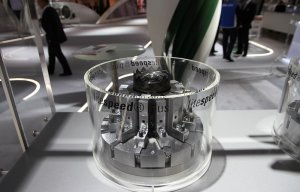
Groz-Beckert’s litespeed plus in action at ITMA Asia
The ‘plus’ stands for more energy savings, temperature reduction, more efficient lubrication behaviour, and reduction of CO2 emissions.

9th December 2015
Knitting Industry
|
Albstadt
Groz-Beckert's presentation of its new product litespeed plus in at the ITMA trade show that took place in Milan in November, the company is receiving the first reactions from the market.
The new product litespeed plus represents an evolution of the previous litespeed version, but with two-sided reduction of needle shank thickness – and it is designed for use in large circular knitting machines. The plus stands for more energy savings, temperature reduction, more efficient lubrication behaviour, and reduction of CO2 emissions, according to the manufacturer.
The minimized friction, improved lubricating properties, and significantly reduced machine temperature all aim to improve handling, and reduce wear on system components. This is also said to allow the maximum machine speed to be fully exploited, and results in optimal needle service life.
The original idea of further developing the geometry of the tried and tested litespeed circular knitting needle led to the creation of a new product – the optimized litespeed plus. In both the litespeed and the litespeed plus, the needle shank thickness has been partially reduced in comparison to a standard form.
While this reduction is on just one side in the litespeed design – either on the left or the right hand side of the needle – the litespeed plus features this partial reduction on both sides. According to the manufacturer, this means that the litespeed plus version can also be used independently of the machine's direction of rotation.
In extreme cases, the speed of modern (high-performance) circular knitting machines can be limited by high temperatures. The reduction in shank thickness on the litespeed plus is said to reduce friction and improve lubricating performance. This demonstrably lowers the temperature, even at high machine speeds, the company reports.
The additional reduction in the contact area due to the reduction of shank thickness on both sides means lower friction between needle and needle trick. This, the manufacturer reports, results in lower power consumption, and thus a reduction in CO2 emissions.

Business intelligence for the fibre, textiles and apparel industries: technologies, innovations, markets, investments, trade policy, sourcing, strategy...
Find out more